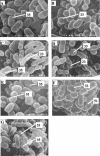Coaggregation among nonflocculating bacteria isolated from activated sludge
- PMID: 14532062
- PMCID: PMC201223
- DOI: 10.1128/AEM.69.10.6056-6063.2003
Coaggregation among nonflocculating bacteria isolated from activated sludge
Abstract
Thirty-two strains of nonflocculating bacteria isolated from sewage-activated sludge were tested by a spectrophotometric assay for their ability to coaggregate with one other in two-membered systems. Among these strains, eight showed significant (74 to 99%) coaggregation with Acinetobacter johnsonii S35 while only four strains coaggregated, to a lesser extent (43 to 65%), with Acinetobacter junii S33. The extent and pattern of coaggregation as well as the aggregate size showed good correlation with cellular characteristics of the coaggregating partners. These strains were identified by sequencing of full-length 16S rRNA genes. A. johnsonii S35 could coaggregate with strains of several genera, such as Oligotropha carboxidovorans, Microbacterium esteraromaticum, and Xanthomonas spp. The role of Acinetobacter isolates as bridging organisms in multigeneric coaggregates is indicated. This investigation revealed the role of much-neglected nonflocculating bacteria in floc formation in activated sludge.
Figures








Similar articles
-
Intergeneric coaggregation of non-flocculating Acinetobacter spp. isolates with other sludge-constituting bacteria.J Biosci Bioeng. 2009 Apr;107(4):394-400. doi: 10.1016/j.jbiosc.2008.11.020. J Biosci Bioeng. 2009. PMID: 19332298
-
Intergeneric coaggregations among Oligotropha carboxidovorans and Acinetobacter species present in activated sludge.FEMS Microbiol Lett. 2003 Jul 15;224(1):23-8. doi: 10.1016/S0378-1097(03)00391-4. FEMS Microbiol Lett. 2003. PMID: 12855163
-
Pair-dependent co-aggregation behavior of non-flocculating sludge bacteria.Biotechnol Lett. 2003 Jun;25(12):981-6. doi: 10.1023/a:1024009511113. Biotechnol Lett. 2003. PMID: 12889835
-
Involvement of Acinetobacter sp. in the floc-formation in activated sludge process.J Biotechnol. 2012 Feb 20;157(4):505-11. doi: 10.1016/j.jbiotec.2011.09.024. Epub 2011 Oct 2. J Biotechnol. 2012. PMID: 22001846
-
Effect of surfactants on stability of Acinetobacter johnsonii S35 and Oligotropha carboxidovorans S23 coaggregates.FEMS Microbiol Ecol. 2005 Feb 1;51(3):313-21. doi: 10.1016/j.femsec.2004.09.005. FEMS Microbiol Ecol. 2005. PMID: 16329879
Cited by
-
Thauera sp. for efficient nitrate removal in continuous denitrifying moving bed biofilm reactor.Bioprocess Biosyst Eng. 2024 Mar;47(3):429-442. doi: 10.1007/s00449-024-02977-7. Epub 2024 Mar 5. Bioprocess Biosyst Eng. 2024. PMID: 38441647
-
Contributions of Escherichia coli and Its Motility to the Formation of Dual-Species Biofilms with Vibrio cholerae.Appl Environ Microbiol. 2021 Aug 26;87(18):e0093821. doi: 10.1128/AEM.00938-21. Epub 2021 Aug 26. Appl Environ Microbiol. 2021. PMID: 34260307 Free PMC article.
-
Enhanced biofilm formation and increased resistance to antimicrobial agents and bacterial invasion are caused by synergistic interactions in multispecies biofilms.Appl Environ Microbiol. 2006 Jun;72(6):3916-23. doi: 10.1128/AEM.03022-05. Appl Environ Microbiol. 2006. PMID: 16751497 Free PMC article.
-
Anti-Bacterial Adhesion on Abiotic and Biotic Surfaces of the Exopolysaccharide from the Marine Bacillus licheniformis B3-15.Mar Drugs. 2023 May 20;21(5):313. doi: 10.3390/md21050313. Mar Drugs. 2023. PMID: 37233507 Free PMC article.
-
Mechanisms of microbial co-aggregation in mixed anaerobic cultures.Appl Microbiol Biotechnol. 2024 Jul 4;108(1):407. doi: 10.1007/s00253-024-13246-8. Appl Microbiol Biotechnol. 2024. PMID: 38963458 Free PMC article. Review.
References
-
- Bossier, P., and W. Verstraete. 1996. Triggers for microbial aggregation in activated sludge? Appl. Microbiol. Biotechnol. 45:1-6.
-
- Boswell, C. D., R. E. Dick, H. Eccles, and L. E. Macaskie. 2001. Phosphate uptake and release by Acinetobacter johnsonii in continuous culture and coupling of phosphate release to heavy metal accumulation. J. Ind. Microbiol. Biotechnol. 26:333-340. - PubMed
-
- Buswell, C. M., Y. M. Herlihy, P. D. Marsh, C. W. Keevil, and S. A. Leach. 1997. Coaggregation amongst aquatic biofilm bacteria. J. Appl. Microbiol. 83:477-484.
-
- Choi, S. C., and Y. S. Oh. 2002. Simultaneous removal of benzene, toluene and xylenes mixture by a constructed microbial consortium during biofiltration. Biotechnol. Lett. 24:1269-1275.
-
- Cookson, A. L., P. S. Handley, A. E. Jacob, G. K. Watson, and C. Allison. 1995. Coaggregation between Prevotella nigrescens and Prevotella intermedia with Actinomyces naeslundii strains. FEMS Microbiol. Lett. 132:291-296.
Publication types
MeSH terms
Substances
LinkOut - more resources
Full Text Sources
Molecular Biology Databases
Miscellaneous

